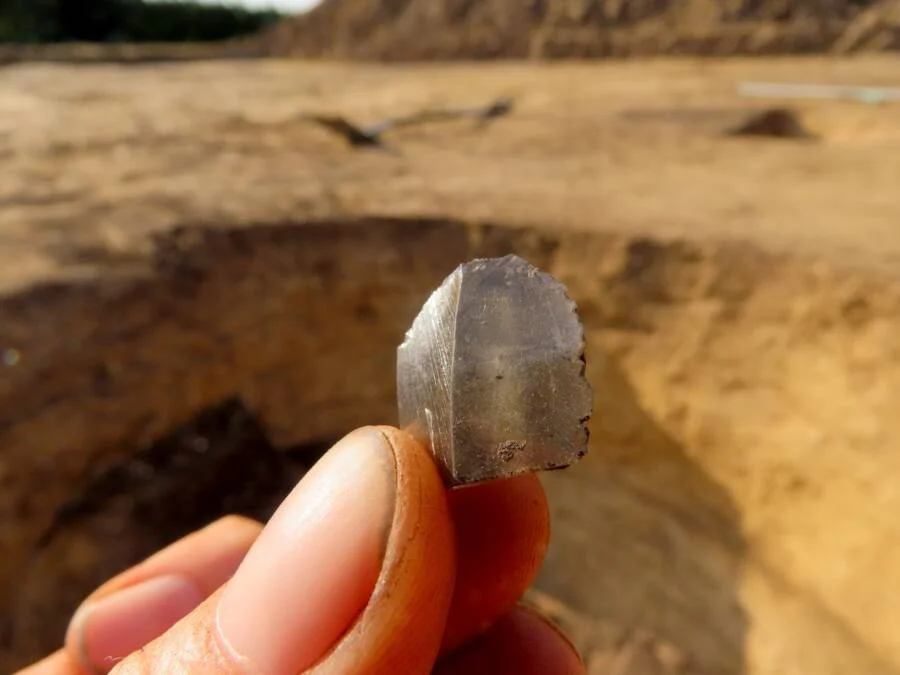In a stunning archaeological find, researchers in southeastern Poland recently uncovered the remnants of a Neolithic longhouse, dating back to 5300-4900 B.C.E., that belonged to the Linear Pottery culture. This discovery, made in the village of Sandomierz-Mokoszyn, provides fascinating insights into the early farming communities of Europe and challenges existing understandings of ancient settlements in the region.
Digging Into the Past: The Search for Funnelbeaker Culture
Initially, the archaeological team set out to uncover a settlement dating to 3500 B.C.E. associated with the Funnelbeaker culture. The Funnelbeaker culture is known for its characteristic pottery and farming techniques, and the site promised to reveal more about these early agricultural societies.
UK Doctor Disguises Himself as a Nurse to Poison His Mother’s Partner With Fake COVID Shot
And it did—but with a twist. What they found was not just what they were looking for, but a much older structure. Instead of focusing solely on the Funnelbeaker culture, archaeologists stumbled upon something much more ancient—remnants of a longhouse built by the Linear Pottery culture, predating the Funnelbeaker artifacts by about 1,500 years.
The Linear Pottery Culture: Early Farmers with a Flair for Design
The Linear Pottery culture, active between 5500 and 4500 B.C.E., is one of Europe’s earliest farming communities. These early farmers didn’t just grow crops; they were also skilled artisans. The name “Linear Pottery” comes from the unique linear designs they carved into their pottery, which has been found across Central Europe.
The newly discovered longhouse measures about 65 feet in length and 20 feet wide, making it a significant structure for its time. It was built using a post-and-beam technique, with walls made from clay pits located nearby. Such longhouses weren’t just homes—they were often the center of village life, providing shelter for families and storage for food.
Dr. Marek Florek, from the Provincial Office for the Protection of Monuments in Sandomierz, highlighted the importance of this find, noting that it is the first longhouse of its kind found in the Sandomierz Upland.

More Than Just A Longhouse: What Else Was Found?
While the longhouse is the headline discovery, the excavation revealed much more. Alongside the structure, archaeologists found a treasure trove of Neolithic artifacts, including:
- Ceramics: Pottery decorated with the distinct designs of the Linear Pottery culture.
- Flint tools: Early implements that would have been essential for farming and daily life.
- Volcanic glass artifacts: Objects made from obsidian, a material not native to Poland, suggesting trade with distant civilizations.
These findings help paint a clearer picture of the Neolithic period in Europe, offering valuable clues about how these early farmers lived, worked, and interacted with their environment. The presence of obsidian, in particular, suggests that even 6,000 years ago, these communities were part of a broader network of trade and cultural exchange.
Longhouses and Permanent Settlements
What makes this discovery especially exciting is what it tells us about the development of permanent settlements during the Neolithic era. Longhouses like the one unearthed in Sandomierz-Mokoszyn were more than just dwellings; they were the heart of a stable, settled way of life. These structures are evidence of a significant shift away from the nomadic lifestyles that had dominated earlier periods.
Dr. Florek emphasized that this longhouse indicates the presence of a settled community rather than a temporary camp, reinforcing the idea that people were living in one place for extended periods. This is a major clue in understanding the transition from hunter-gatherer societies to agricultural ones, marking the Neolithic period as a time of dramatic social and cultural evolution.
The Bigger Picture: What Does This Mean for Archaeology?
Discoveries like the one in Poland force us to rethink what we know about the Neolithic period in Europe. The fact that this longhouse is the first of its kind found in the Sandomierz region suggests that there may be many more hidden treasures waiting to be discovered.
Moreover, the excavation points to a continuity of settlement in the region, with people living there for thousands of years. The area around Sandomierz seems to have been a hub of activity long before written history began. This continuity challenges the assumption that early farming communities were transient or isolated. Instead, it suggests that they were part of a complex web of trade and cultural exchange that stretched across Europe.

What’s Next?
For now, the artifacts and longhouse remains are headed to the Sandomierz Castle Museum, where they will be preserved and studied. Researchers hope to learn even more about the Linear Pottery culture and its impact on the development of farming communities in Central Europe.
As these ancient objects are analyzed, they promise to shed light on the daily lives of the people who lived in the longhouse—what they ate, how they worked, and how they interacted with other cultures. There’s much more to uncover, and each new discovery brings us one step closer to understanding the distant past.
Stay Curious, Stay Engaged
This discovery in Poland is a reminder of how much we still don’t know about the ancient world. Every archaeological dig has the potential to rewrite history, revealing new insights about how our ancestors lived and what they left behind.
If you’re fascinated by history and archaeology, there are plenty of ways to get involved. Consider visiting a local museum or following archaeological news for the latest updates. And who knows? The next big discovery might be right under your feet.

